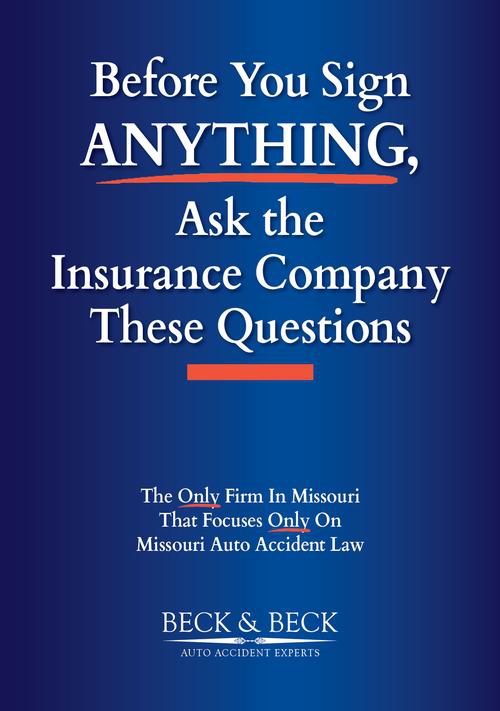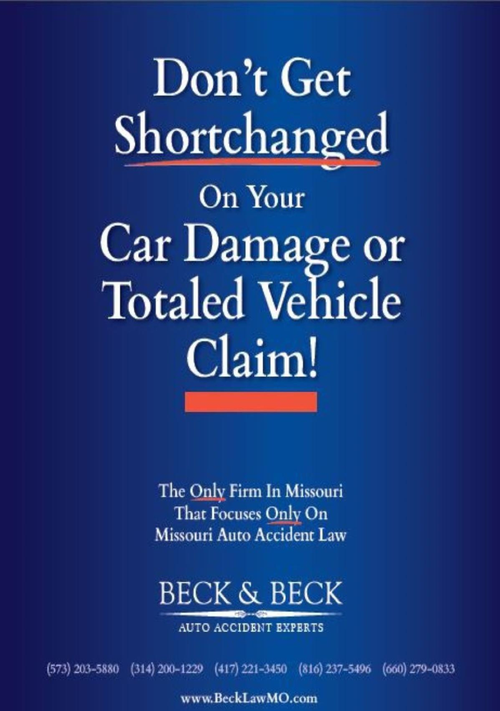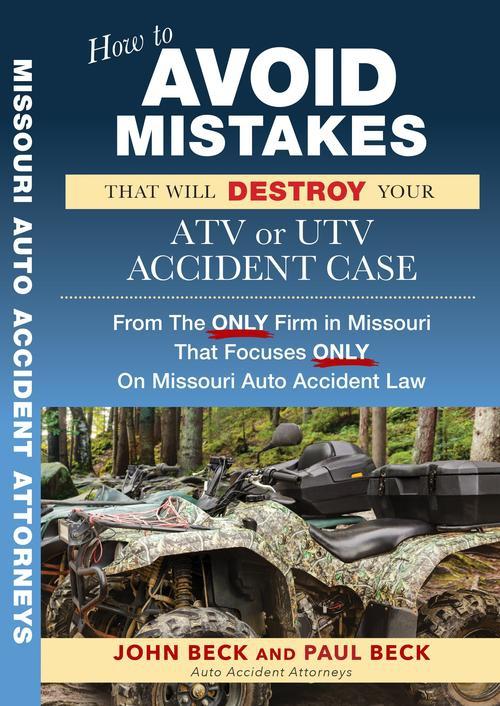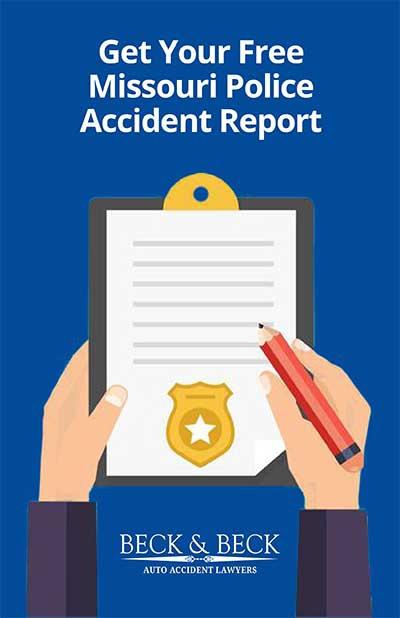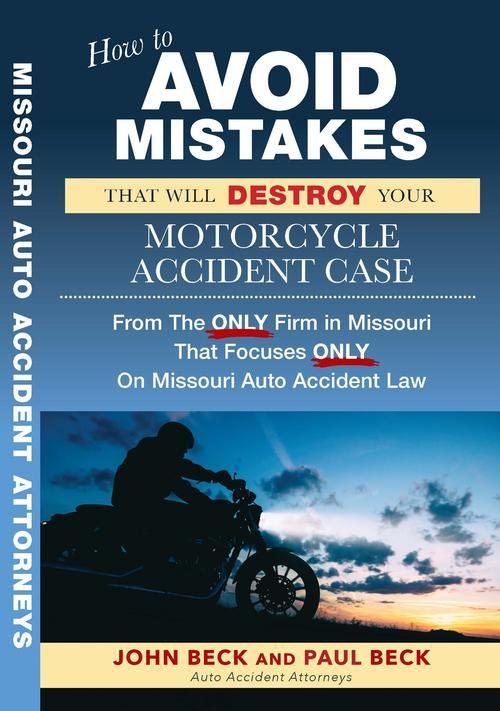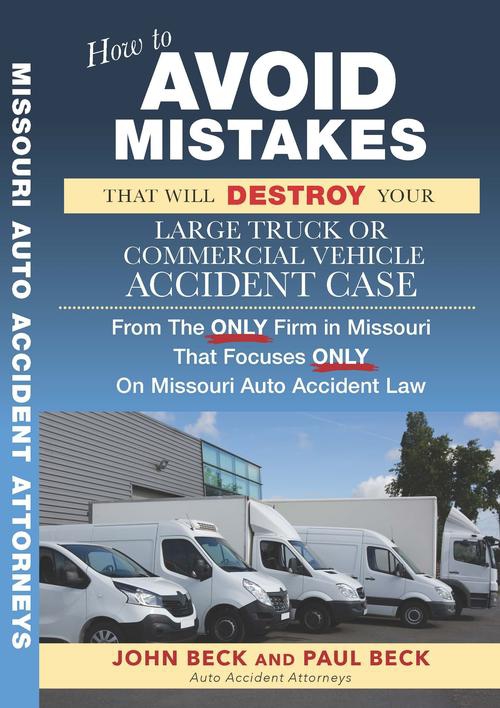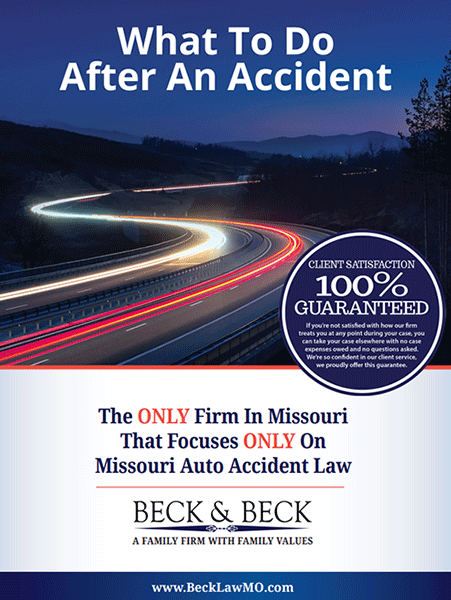Unlike car accidents involving two cars in St. Louis, Missouri, chain reaction collisions are more complicated since they can involve multiple at-fault parties.
Determining fault in St. Louis pileups requires investigating every driver’s actions, road conditions, and potential mechanical failures that contributed to the sequence of collisions.
Our experienced St. Louis multi-vehicle accident lawyers can help you recover compensation for your injuries if you’ve been involved in a chain-reaction accident. Since 1990, Beck & Beck Missouri Car Accident Lawyers has been assisting auto accident victims. Contact us today to speak with our skilled attorneys.
Have you been injured in an accident involving multiple cars in St. Louis? Our experienced multi-vehicle accident attorneys in St. Louis will fight for you. Call (314) 207-9996 to speak with our legal team today.
How We Build Your St. Louis Multi-Vehicle Accident Case
Beck & Beck Missouri Car Accident Lawyers is the only firm in Missouri that focuses exclusively on auto accident law. Our family-run practice provides personalized attention and dedicated representation to every client.
Rapid Investigation and Spoliation Letters
Our team acts promptly to preserve critical evidence before it is lost. We immediately send spoliation letters demanding preservation of vehicle data, surveillance footage, driver logs, and cell phone records.
Time is your enemy in multi-vehicle cases. Evidence vanishes quickly, and insurance companies know this. We act fast to level the playing field.
Identifying All Liable Parties and Coverages
We conduct thorough investigations to identify every potentially liable party and available insurance coverage:
- Run comprehensive background checks on all drivers
- Investigate employment relationships and commercial policies
- Search for umbrella coverage that provides additional limits
- Check for government liability in road design cases
No potential source of compensation goes unexplored.
Negotiation and Litigation if Needed
We prepare every case for trial while negotiating aggressively for fair settlements. Insurance companies know we’ll take cases to court, which strengthens our position at the negotiating table.
Most cases settle without trial, but our litigation experience ensures you’re never forced to accept an inadequate offer.
What Is a Multi-Vehicle or Chain-Reaction Crash?
A multi-vehicle accident involves multiple vehicles colliding in a single crash. Chain-reaction crashes happen when one collision triggers others, like dominoes falling in a row.
Picture this common St. Louis scenario: during rush hour on I-270, traffic suddenly stops. The first car brakes safely, but the second car rear-ends it, pushing it into the third car ahead. This can lead to a three-car pileup if one driver makes a mistake.
These crashes rarely have just one person at fault. Multiple drivers often share responsibility, and several insurance companies get involved. Missouri’s laws determine how much each person pays based on their percentage of blame.
How Is Fault Determined in Missouri Multi-Vehicle Crashes?
Missouri uses ‘pure comparative fault‘ to assign blame in multi-car accidents. This system gives each driver a percentage of fault based on what they did wrong. Your percentage of fault directly reduces how much money you can recover.
Police reports document what happened at the scene, but they don’t legally decide who’s at fault. Insurance companies and courts make that decision after reviewing all the evidence. They look at witness statements, photos, vehicle damage, and sometimes bring in accident experts.
How Does Pure Comparative Fault Affect My Case?
You can still get compensation even if you’re partially to blame for the accident. Your fault percentage simply reduces your payout dollar for dollar.
Here’s how it works: Imagine you have significant medical bills and lost wages from a multi-vehicle pileup. The investigation shows you were 30% at fault for following too closely. The amount you can still recover is 70,000 recoverable, which equals your total damages minus your 30% share of fault.
This rule protects you even if you made a mistake. As long as someone else also contributed to the crash, you have a valid claim.
Does Joint and Several Liability Apply to Economic Losses?
Missouri has a special rule for economic damages like medical bills and lost wages. If any driver is found 51% at fault, they can be forced to pay your entire economic losses. This means you don’t have to chase down multiple drivers for small portions of your bills.
This rule only applies to economic damages, not pain and suffering. It also helps when one at-fault driver doesn’t have enough insurance to cover your losses.
Who Can Be Liable in a St. Louis Chain-Reaction Crash?
Liability in a pileup extends far beyond just the drivers involved. Multiple parties can share responsibility depending on what caused the crash. We investigate every possible source of compensation to strengthen your case.
Potentially liable parties include:
- Other drivers: Anyone whose actions contributed to the collision sequence
- Employers: Companies whose workers caused crashes while on the job
- Trucking companies: Commercial carriers with higher safety obligations
- Government agencies: Entities responsible for dangerous road conditions
- Manufacturers: Companies that made defective vehicle parts
Drivers and Employers
When someone causes an accident while working, their employer often shares the blame. This legal rule is called vicarious liability, and it applies to delivery drivers, rideshare operators, and anyone driving a company vehicle for work.
The key factor is whether the driver was doing their job when the crash happened. Running personal errands usually breaks this connection, but work-related driving creates employer liability.
Commercial Carriers and Trucking Companies
Trucking companies face stricter safety rules than regular drivers. Federal law requires electronic logging devices that track driving hours, regular vehicle inspections, and driver qualification checks. These records often reveal violations that contributed to crashes.
Semi-trucks need much more distance to stop than cars, especially when loaded. This makes truck drivers frequent contributors to highway pileups, and their companies often share the blame.
Government Entities for Dangerous Roads
Cities, counties, and the state can be liable when poor road conditions cause crashes. Dangerous situations include missing stop signs, broken traffic lights, poorly designed merge lanes, and unmarked construction zones.
Government claims have much shorter deadlines than regular cases. You typically have just 90 days to file a formal notice, so quick action is essential.
Vehicle or Part Manufacturers
Mechanical failures can trigger multi-vehicle accidents. Common examples include brake system failures, tire blowouts, and steering component defects. When defective parts cause crashes, the manufacturer can be held responsible alongside the drivers.
These product liability claims run parallel to your case against other drivers. They provide an additional source of compensation when mechanical problems contribute to the accident.
Common Multi-Vehicle Scenarios in St. Louis
St. Louis pileups follow predictable patterns based on our local roads and traffic conditions. Understanding these scenarios helps explain how liability gets assigned in different situations.
Rear-End Chain Reactions
The most common scenario starts with a simple rear-end collision that creates a domino effect. Car A stops normally, Car B hits Car A from behind, and the impact pushes Car A into Car C ahead.
Car B’s driver usually bears primary responsibility for starting the chain reaction. However, Car A’s driver might share fault if they stopped suddenly without warning or had broken brake lights.
The damage patterns tell the story. We examine each impact point to determine the sequence of collisions and assign appropriate fault percentages.
Highway Pileups on I-64, I-44, I-55, I-270
High-speed crashes on St. Louis highways create the most dangerous pileups. These often happen in construction zones where traffic suddenly slows, near major interchanges where drivers make aggressive lane changes, or during rush hour congestion.
Speed makes these crashes more severe and fault determination more complex. Drivers who fail to adjust for conditions or follow too closely at highway speeds face higher fault percentages.
Weather conditions near the Mississippi River bridges add another layer of complexity. Fog, ice, and sudden rain showers create visibility and traction problems that experienced drivers should anticipate.
Intersections and Stop-and-Go Traffic
Downtown St. Louis intersections see frequent multi-vehicle accidents during heavy traffic periods. These usually involve distracted drivers who don’t notice stopped traffic ahead, creating low-speed but expensive chain reactions.
Left-turn accidents at busy intersections can trap multiple vehicles in the middle of the road. When the light changes, additional cars may strike the vehicles already involved in the initial collision.
Traffic cameras at many St. Louis intersections provide crucial evidence for these cases. We immediately request footage before it gets deleted or recorded over.
Weather and Low-Visibility Events
Missouri weather creates challenging driving conditions that contribute to pileups. River valley fog, black ice on overpasses, and sudden thunderstorms all reduce visibility and traction.
Bad weather doesn’t excuse negligent driving. Drivers must slow down and increase following distance when conditions deteriorate. Failing to adjust for weather conditions often increases a driver’s fault percentage.
We examine weather reports from the time of your crash to determine if conditions played a role. This information helps establish whether other drivers acted reasonably for the circumstances.
What Evidence Proves Liability in a Pileup?
Building a strong case requires gathering evidence quickly before it disappears. Traffic cameras get overwritten, witnesses forget details, and physical evidence gets cleared away. Our experienced car accident attorneys in St. Louis act immediately to preserve everything that supports your claim.
Police Reports and Witness Statements
Police reports provide the official documentation of what happened at the scene. Officers interview drivers and witnesses, measure skid marks, and create diagrams showing vehicle positions. While not legally binding, these reports carry significant weight with insurance companies.
Witness statements offer neutral perspectives that can tip the scales in your favor. We track down everyone who saw the crash, including people who left before police arrived.
Traffic and MoDOT Cameras and Dashcams
Video evidence is often the strongest proof of what really happened. St. Louis has extensive camera coverage that can capture your accident from multiple angles.
We immediately send preservation letters to:
- MoDOT for highway camera footage
- The city for intersection cameras
- Nearby businesses for security camera recordings
- Other drivers for dashcam footage
Because recordings are often overwritten, it’s critical to preserve footage promptly.
Vehicle Event Data Recorders and Telematics
Modern cars have ‘black boxes’ called Event Data Recorders that capture speed, braking, and steering data in the seconds before impact. This information can prove whether drivers tried to avoid the crash or were distracted.
We work with technical experts to download and analyze this data before insurance companies can access it. The information often contradicts what drivers claim happened.
Photos, Skid Marks, Debris, and Damage Patterns
Physical evidence at the crash scene tells the story of how events unfolded. Skid marks show where drivers tried to brake, debris patterns indicate impact points, and damage angles reveal which collisions happened first.
We photograph everything before tow trucks remove the vehicles. Final vehicle positions help reconstruct the accident sequence and determine fault percentages.
Phone Records and Distraction Proof
Cell phone records can prove whether drivers were texting or calling at the time of the crash. We subpoena these records when distraction is suspected, as it often shifts significant fault to the distracted driver.
Social media posts and app usage data can also reveal distraction. Many people don’t realize how much digital evidence exists of their activities.
What To Do After a Multi-Vehicle Crash
Your actions immediately after a pileup can protect both your health and your legal rights. Following the right steps helps preserve evidence and strengthens your eventual claim.
Safety and 911
Move to safety if you can do so without risking further injury. Call 911 immediately, even if injuries seem minor. Request ambulance evaluation because adrenaline can mask serious injuries.
Police reports are essential for multi-vehicle crashes because they document all parties involved. Without an official report, insurance companies may try to exclude some drivers from liability.
Document and Exchange Information
Take photos of all vehicles from multiple angles, showing damage and final positions. Get insurance information from every driver involved, not just the one who hit you directly.
Write down witness contact information before they leave the scene. Note weather conditions, road hazards, and anything unusual about the situation.
See a Doctor and Track Costs
See a doctor within 24 hours, even if you feel fine. Some injuries don’t show symptoms immediately, and insurance companies use treatment delays against you.
Start a file for all accident-related expenses including medical bills, prescriptions, missed work days, and transportation costs. This documentation directly impacts your compensation amount.
Avoid Recorded Statements
Other drivers’ insurance companies will call quickly asking for recorded statements. Politely decline and refer them to your attorney. These statements are often used to reduce or deny your claim.
Don’t admit fault or speculate about what happened. Stick to basic facts about your injuries and property damage.
Contact a St. Louis Car Accident Lawyer
Multi-vehicle cases are too complex to handle alone. Insurance companies use teams of lawyers and experts to minimize payouts. You need experienced legal representation to level the playing field.
We handle all communication with insurance companies, preserve evidence before it disappears, and identify every source of compensation. Early legal involvement protects your rights and maximizes your recovery.
Who Pays for Damages in Multi-Vehicle Claims?
Multi-vehicle crashes involve multiple insurance policies that can contribute to your settlement. Understanding how these coverages work together helps you know what to expect during the claims process.
Coordinating Multiple Insurance Policies
Different types of coverage apply in specific situations, and knowing the hierarchy helps maximize your recovery:
Coverage Type | When It Applies | Typical Limits |
At-fault drivers’ liability | Primary coverage for your damages | $25,000-$100,000+ |
Your collision coverage | Immediate vehicle repairs | Actual car value |
Your UM/UIM coverage | When others lack adequate insurance | Your policy limits |
Umbrella policies | Excess coverage over primary limits | $1M-$5M |
We identify all available policies across every involved party to maximize your compensation.
Using UM, UIM, and MedPay
Your own insurance provides important backup coverage when other drivers can’t fully pay for your damages:
- Uninsured Motorist (UM): Covers you when the at-fault driver has no insurance
- Underinsured Motorist (UIM): Fills gaps when the at-fault driver doesn’t have enough coverage
- Medical Payments (MedPay): Pays medical bills immediately regardless of who’s at fault
These coverages protect you in complex multi-vehicle situations where fault and insurance coverage vary widely.
Subrogation and Medical Liens
Health insurance companies and medical providers often claim part of your settlement through liens or subrogation rights. We negotiate these claims down to maximize what you keep from your recovery.
This process may reduce the amounts you owe to healthcare providers and insurers.
Act Fast Deadlines Apply in Missouri
Missouri law sets strict deadlines that can eliminate your right to compensation if missed. Don’t let time limits destroy your claim.
Five-Year Statute for Injury Claims
You have five years from the accident date to file a lawsuit for personal injuries. While this seems like plenty of time, evidence disappears and witnesses forget. Earlier action means stronger cases.
The clock starts ticking immediately after your crash. Waiting too long can make it impossible to gather the evidence needed to prove your case.
Shorter Deadlines for Government Claims
Claims against government entities for dangerous road conditions have much shorter deadlines. You typically have just 90 days to file a formal notice of your claim. Missing these deadlines can eliminate otherwise valid claims worth significant money. Government liability often provides the best source of compensation in road design cases.
Reach Out To Our Auto Accident Law Firm in St. Louis, Missouri, Today
If you’ve been hurt in a multi-vehicle crash in St. Louis, don’t face the insurance companies alone. Beck & Beck Missouri Car Accident Lawyers provides free consultations 24/7 with no fees unless we win your case.
We serve clients throughout St. Louis, St. Charles County, Jefferson County, and across Missouri. Our family values and personal attention ensure you’re never treated like just another case number.
Contact us today to protect your rights and start building your strongest possible case.


